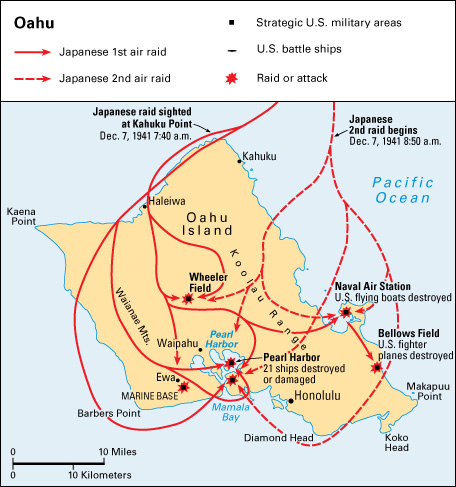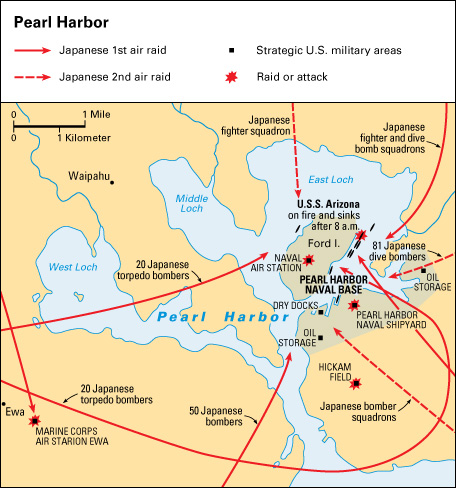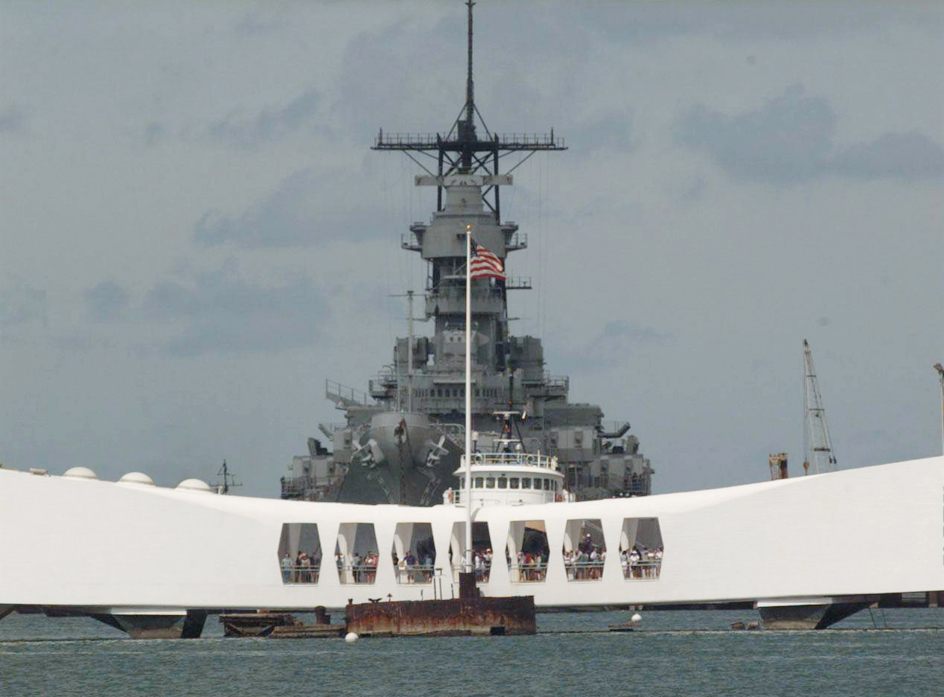Pearl Harbor was the site of a surprise attack on the United States by Japanese military forces on Dec. 7, 1941. Japanese ships and airplanes attacked the United States naval base at Pearl Harbor on the island of Oahu in Hawaii. The attack caused heavy casualties and destroyed much of the American Pacific Fleet. The attack also brought the United States into World War II . “Remember Pearl Harbor” became the rallying cry for the country. American participation was a main reason why the Allied nations, including the United Kingdom and Soviet Union, defeated the Axis nations, headed by Japan and Germany. Loading the player...
Attack on Pearl Harbor
Background.
Japan began a military expansion during the 1930’s. It invaded China and much of Southeast Asia. Japan wanted to acquire the rich resources of Asia. The United States protested this aggression. It demanded that Japan stop its actions, but Japan ignored the demand. The United States then cut off exports to Japan. Japan had few natural resources, and it relied on exports of petroleum and other goods from the United States.

General Hideki Tojo became premier of Japan in October 1941. Tojo and other Japanese military leaders realized that only the United States Navy had the power to block Japan’s expansion in Asia. They decided to try to cripple the U.S. Pacific Fleet at anchor in Pearl Harbor.
The attack.
On December 7, the U.S. secretary of state met with two Japanese diplomats in Washington. While they talked, the Japanese military had already launched the attack on the U.S. facilities at Pearl Harbor. In the United States, the attack became known as the “Pearl Harbor sneak attack.”

Franklin Roosevelt responds to Pearl Harbor attack
On December 7, Vice Admiral Chuichi Nagumo led a 33-ship Japanese striking force that steamed under the cover of darkness to about 230 miles (370 kilometers) north of Oahu. Early in the morning, his aircraft carriers launched 350 airplanes against the United States Fleet. The first bombs fell at about 7:55 a.m. The chief targets were 8 battleships among the 180 American vessels anchored in the harbor. The attack killed 2,388 people at Pearl Harbor and wounded about 2,000. It destroyed or damaged 21 American ships and more than 300 planes. The Japanese lost 29 aircraft.
On December 8, U.S. President Franklin D. Roosevelt addressed Congress. He called December 7 “a date which will live in infamy.” Congress declared war on Japan. In a radio speech the same day, Roosevelt urged Americans to back the war effort and avenge Pearl Harbor. He said, “Every single man, woman, and child is a partner in the most tremendous undertaking of our American history.”
At the time of the attack, Nazi Germany had taken over much of Europe. The U.K. and the Soviet Union provided the main resistance to the Nazis. The United States had stayed out of the war. However, under President Roosevelt’s leadership, the United States provided extensive aid to the United Kingdom. Germany declared war on the United States on December 11.
Japan won many battles and gained much territory in the early days of U.S. participation in the war. However, a massive effort to produce equipment and supplies built American military strength. The slogan “Remember Pearl Harbor” helped boost the morale of the population. The Allies gradually turned the tide against Japan and Germany. The long war, which had begun in 1939, ended in 1945 with the surrender of the Axis countries.
The war memorials.
The ships destroyed in the Pearl Harbor attack include the USS Arizona. The battleship sits upright on the bottom of the harbor with more than 1,000 men entombed aboard. The USS Arizona Memorial, a roomlike structure, stands above the ship. The memorial is supported by pilings that reach the harbor bottom. The names of those who died on the Arizona are carved in marble at one end of the room. Even today, bubbles of oil from the sunken Arizona rise to the water’s surface. In 1999, the USS Missouri was opened to the public, as the Battleship Missouri Memorial, in Pearl Harbor. The Japanese surrendered to the Allies on board Missouri on Sept. 2, 1945.

Pearl Harbor as a naval base.
In 1887, King Kalakaua of Hawaii gave the United States the right to develop a coaling station at Pearl Harbor. The harbor’s name came from the pearl oysters that once grew in its waters. The United States made its first attempt to deepen the channel through the reef outside the harbor in 1902. The first dry dock was completed in 1919.
Pearl Harbor is now the site of Joint Base Pearl Harbor-Hickam. The base is the headquarters of both the U.S. Air Force’s Pacific Air Forces and the U.S. Navy’s Pacific Fleet.
